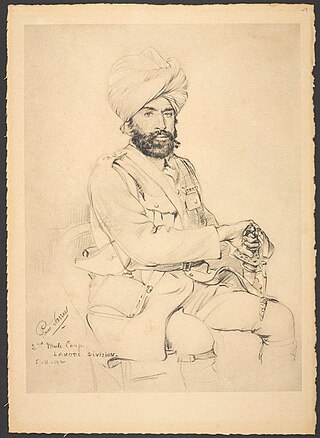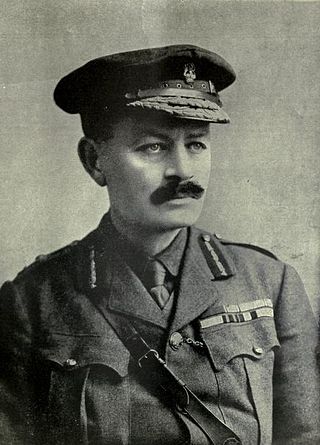
The 4th Indian Infantry Division, also known as the Red Eagle Division, is an infantry division of the Indian Army. This division of the British Indian Army was formed in Egypt in 1939 during the Second World War. During the Second World War, it took part in campaigns in East Africa, Syria, North Africa and Italy. Post independence, the division is part of the I Corps and headquartered at Prayagraj.

The 19th Indian Infantry Division was an infantry division of the Indian Army during World War II, and played a prominent part in the final part of the Burma Campaign.
Iraqforce was a British and Commonwealth formation that came together in the Kingdom of Iraq. The formation fought in the Middle East during World War II.

The British Expeditionary Force order of battle 1914, as originally despatched to France in August and September 1914, at the beginning of World War I. The British Army prior to World War I traced its origins to the increasing demands of imperial expansion together with inefficiencies highlighted during the Crimean War, which led to the Cardwell and Childers Reforms of the late 19th century. These gave the British Army its modern shape, and defined its regimental system. The Haldane Reforms of 1907 formally created an Expeditionary force and the Territorial Force.

The 7th (Meerut) Division was an infantry division of the Indian Army and before 1895, the Bengal Army, that saw active service during World War I.

The 3rd (Lahore) Division was an infantry division of the Indian Army and before 1895, the Bengal Army, first organised in 1852. It saw service during World War I as part of the Indian Corps in France before being moved to the Middle East where it fought against troops of the Ottoman Empire.
The 2nd (Rawalpindi) Division was a regular army division of the British Indian Army. It was formed in 1903 after the Kitchener reforms of the Indian Army. During World War I it remained in India for local defence but it was mobilised for action on the North West Frontier on several occasions during the period. The Division was mobilised in 1919 for service during the Third Afghan War.
The 8th (Lucknow) Division was a formation of the British Indian Army's Northern Army that was first formed as a result of the Kitchener reforms of the Indian Army in 1903. The Division remained in India on internal security duties during World War I, though the 8th (Lucknow) Cavalry Brigade was transferred to the 1st Indian Cavalry Division and served in France on the Western Front, and the 22nd Lucknow Infantry Brigade served as part of the 11th Indian Division in Egypt.
This is the order of battle for the Syria–Lebanon campaign, a World War II campaign between the Western Allies and Vichy France during June and July, 1941.
The Burma Division was a static formation of the British Indian Army. It was created as part of the 1903 reforms of the Indian Army by Herbert Kitchener, 1st Earl Kitchener then Commander-in-Chief, India. The task of such formations was to oversee area brigades commanding Internal Security troops. The formation is best thought of as a provincial or district command rather than as an infantry division. The headquarters of the division was at Maymyo.
The Rawalpindi Parade 1905 was a parade by the British Indian Army held in Rawalpindi on 8 December 1905 to honour the Prince and Princess of Wales. The troops were under the Command of Horatio Herbert, Viscount Kitchener of Khartoum, G.C.B., O.M., G.C.M.G., Commander-in-Chief India. The Royal party arrived at the parade ground escorted by a Field Officer's escort of 1st Skinner's Horse. They then received a Royal salute and inspected the troops, accompanied by the Commander-in-chief. On conclusion of the inspection, the troops on parade marched past in the following order.

The 5th Indian Infantry Brigade was an infantry brigade formation of the Indian Army during World War II. It was converted from the 9th Indian Infantry Brigade in September 1939, and assigned to the 4th Indian Infantry Division. The brigade first moved to Egypt and took part in the early battles in North Africa. Then in 1941, it moved to the Sudan with the 5th Indian Infantry Division. Returning to 4th Indian Division command it took part in the Syria-Lebanon Campaign. The brigade then returned to North Africa coming under command of the 5th and 10th Indian Infantry Divisions, and the 50th (Northumbrian) Infantry Division and the 51st (Highland) Infantry Division in the Campaign in Tunisia. The brigade once more returned to the 4th Division for the Italian Campaign and the Greek Civil War.
The 21st Indian Infantry Brigade was an infantry brigade formation of the Indian Army during World War II.
Second Battle of Monte Cassino order of battle February 1944 is a listing of the significant formations that were involved in the fighting on the Winter Line in February 1944 during the period generally known as the Second Battle of Monte Cassino.
In September 1939, the British Army was in process of expanding their anti-aircraft and mobile assets. Among these new changes was the formation of Anti-Aircraft Command which was formed on 1 April 1939, and the 1st Armoured Division formed in 1937. The list below will include the British Army units, colonial units, and those units which were in the process of formation.

The Force in Egypt was a British Army formation established in August 1914 to administer garrisoning armed forces in Egypt at the beginning of the First World War. The force had the objective of protecting the Suez Canal and was originally commanded by Major General Julian Byng, but he was replaced by General J. Maxwell, who took command on 8 September 1914. Initially, the main threat to the Suez came from Germany and throughout the early months several of the force's elements were sent to Europe to take part in the fighting on the Western Front. On 5 November 1914, Britain and France declared war on the Ottoman Empire, after which the Force in Egypt faced a direct threat from Ottoman forces, which was realised in February 1915 with a raid on the Suez Canal. This threat remained until 1916 when the British forces went on the offensive.

This is an order of battle listing the Allied and Ottoman forces involved in the Gallipoli campaign during 1915.
The Structure of the Egyptian Expeditionary Force over the course of the First World War is shown below.







